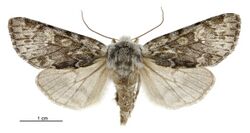Biology:Ichneutica cana
| Ichneutica cana | |
|---|---|

| |
| Female | |

| |
| Male | |
| Scientific classification | |
| Domain: | Eukaryota |
| Kingdom: | Animalia |
| Phylum: | Arthropoda |
| Class: | Insecta |
| Order: | Lepidoptera |
| Superfamily: | Noctuoidea |
| Family: | Noctuidae |
| Genus: | Ichneutica |
| Species: | I. cana
|
| Binomial name | |
| Ichneutica cana Howes, 1914[1]
| |
| Synonyms[1] | |
| |
Ichneutica cana is a moth of the family Noctuidae. It is endemic to New Zealand.[1]
Taxonomy
I. cana was first described by George Howes in 1914 from a single male specimen collected in the Garvie Mountains, near Lake Wakatipu in Otago.[2] This species was illustrated and discussed in George Hudson's 1928 book The Butterflies and Moths of New Zealand.[3] John S. Dugdale agreed with the placement of this species within the genus Ichneutica in 1988.[4] Robert J. B. Hoare also confirmed the placement of this species within the genus Ichneutica in his major review of New Zealand Noctuidae species in 2019.[1]
Description
Howes originally described the species as follows:
Face grey. Palpi blackish at base. Head and thorax grey, frontal area lighter grey. Head and thorax densely clothed with long dark-grey hair. Thorax broad in proportion to length, with a slight posterior crest. Abdomen grey. Forewings grey, with pale grey lines and occasional darker marks. A single light-grey line at base; a jagged grey line about 1⁄5, strongly dentate near dorsum; outwardly suffused with dark grey. Orbicular faintly shown in light grey, and separated from reniform by a distinct dark-grey patch. Reniform faintly outlined in light grey. A jagged light-grey line at 3⁄4, bending towards termen until centre of wing, then inwards before reaching dorsum. Terminal edge margined with light grey, edged basally with a dark suffusion, which forms a faintly defined line; slight grey marks along veins where they reach termen. Cilia short, light grey and dark grey alternate patches. Hindwings light grey with a faint ochreous tinge, a darker band across wing at J and a slightly waved subterminal band. Terminal edge and cilia grey-white. Underside grey with a faint ochreous tinge and a well-defined irregular dark-grey line at about 3⁄4 across both wings.[2]
I. cana is similar in appearance to I. eris but there are visual differences between the two species.[1]
Geographic range
This species is found only in the South Island, in the eastern and southern parts of that Island as well as in Fiordland.[1] Unlike I. eris, I. cana does not appear to be present in the north-west of the South Island.[1]
Habitat
I. cana can be found in alpine habitat.[1]
Life history and host species
The life history of this species is unknown as are the host species of its larvae.[1]
Behaviour
The adults of this species are on the wing during December and January.[1] The males of this species are on the wing during sunny days, and both sexes are attracted to light.[1]
References
| Wikimedia Commons has media related to Ichneutica cana. |
- ↑ 1.00 1.01 1.02 1.03 1.04 1.05 1.06 1.07 1.08 1.09 1.10 Hoare, Robert J. B. (9 December 2019). "Noctuinae (Insecta: Lepidoptera: Noctuidae) part 2: Nivetica, Ichneutica". Fauna of New Zealand 80: 1–455. doi:10.7931/J2/FNZ.80. https://www.wikidata.org/wiki/Q94481265.
- ↑ 2.0 2.1 , Wikidata Q104451396
- ↑ Hudson, George Vernon (1928). The Butterflies and Moths of New Zealand. Wellington: Ferguson & Osborn Ltd.. pp. 50. https://www.wikidata.org/wiki/Q58593286.
- ↑ , Wikidata Q45083134
Wikidata ☰ Q13357915 entry
 |

